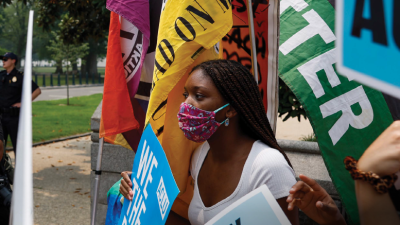
The authenticity of an organization’s actions to advance diversity, equity, accessibility, and inclusion (DEAI) is judged by two key factors: their consistency and comprehensiveness. Companies that have been commended on their approach to racial justice, like Ben & Jerry’s, have been so because their efforts began before and will endure beyond when DEAI is in the spotlight on national news. Their commitment permeates the entire institution, from internal people practices, to supportive action with external partners, to their supply chain and products. And while Ben & Jerry’s readily admits that they still have room to grow and improve, their long-standing support of racial justice has garnered them widespread legitimacy in a national landscape where Americans remain divided on the genuineness of corporate responses to social issues.
Unfortunately, organizations like these are the exception. Many long-standing and widespread practices are directly at odds with advancing DEAI in the workforce, even at times when boards and CEOs are making external statements of commitment to racial justice. One example, which I would like to explore here, is that personal relationships often play a role in getting certain resumes to the top of the pile, or getting an “extra look” in the college admissions process for legacy students. Yet access to those critical relationships has never been equitably distributed. More often than not, these “recommendations” reinforce the advantages that uphold structural inequities, by lifting up those candidates already benefiting from the status quo, while blocking others who are already at the margins.
Over the course of my career, whenever a board member or senior leader has recommended a candidate to me for an open role, that candidate has typically been white, upper class, and from a select set of educational institutions. Regardless of the virtue of the recommenders’ intention, every time they put forth a candidate part of groups already overrepresented in the current workforce, they make it that much more difficult to advance racial equity on teams across the organization. Because of the power dynamics at play, their “suggestion” is often taken as much more than one—if I get a proposed candidate from a board member, I’m essentially receiving a request from someone in power who holds the purse strings to my job and livelihood. Though it is certainly conceivable not to move forward with the candidates they propose, it is not outside the realm of possibility that continuously denying these requests could lead to consequences, be they interpersonal or professional.
The effect is particularly damaging at smaller organizations where the number of open positions are few and turnover is low, meaning opportunities to meaningfully advance racial equity in the workforce are relatively rare unless people leave. This kind of nepotism can therefore seriously stymie DEAI efforts, even when those in leadership positions make claims acknowledging their importance.
In order to shift this paradigm, organizations should consider the following:
- Sharing detailed workforce demographic data with the board and key decision-makers directly, so they can understand how the representation of the organization perpetuates the status quo. Providing this context frames the conversation with DEAI values at the center and can be a helpful baseline for further discussion.
- Anchoring the organization’s DEAI goals as a form of accountability. Any time someone puts forth a family or personal relation for an open role, ask that individual to reflect on whether or not their recommendation advances the organization’s commitment to racial equity in the workforce.
- Investigating what biases are inherent in the organization’s notion of “qualifications” and whether those criteria are unintentionally stifling racial equity in the workforce.
- Educating the board and other institutional leaders about systemic racism and the ways in which their own actions may be complicit in perpetuating inequitable systems.
- Creating intentional opportunities and programs to expand the organization’s networks and relationship base through affinity groups, trade associations, pipeline programs, and search firms with an explicit commitment to racial equity and diversity.
Most importantly, organizations must model institutional goals around workforce diversity and racial justice at every level, all the time. It is not enough for us to put forth statements of solidarity without backing them up with consistent and concrete action. This starts by changing internal practices that continue to preference the well-networked and by “calling in” leaders whose actions get in the way of real change. Shifting this paradigm requires a deeper understanding of our own roles in advancing racial justice and creating a more equitable playing field, by recognizing age-old practices of privileging personal connections as a form of nepotism that perpetuates racial inequity. Our actions must align with the organizations our words say we want, so that we may actually become them.
Skip over related stories to continue reading article








Ageism is also an inequity in the field. It’s quite frustrating.